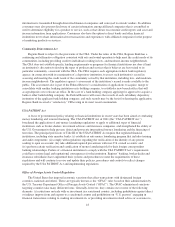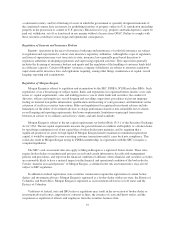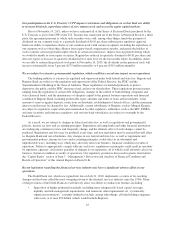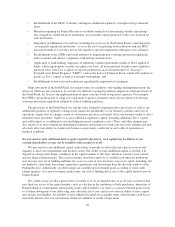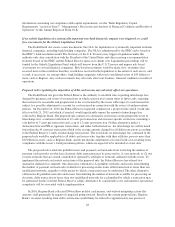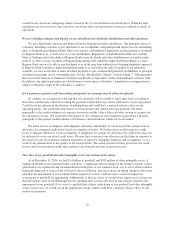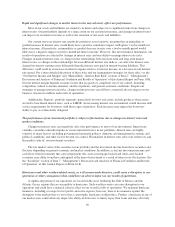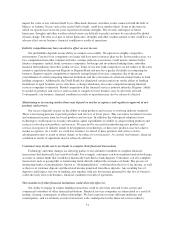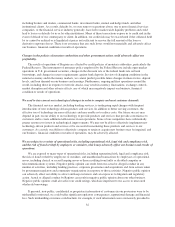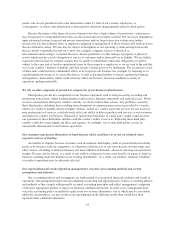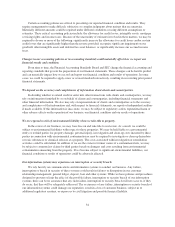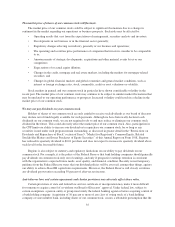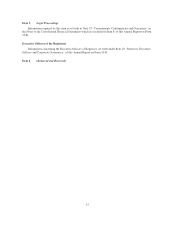Regions Bank 2010 Annual Report Download - page 42
Download and view the complete annual report
Please find page 42 of the 2010 Regions Bank annual report below. You can navigate through the pages in the report by either clicking on the pages listed below, or by using the keyword search tool below to find specific information within the annual report.information concerning our compliance with capital requirements, see the “Bank Regulatory Capital
Requirements” section of Item 7. “Management’s Discussion and Analysis of Financial Condition and Results of
Operation” of this Annual Report on Form 10-K.
If an orderly liquidation of a systemically important non-bank financial company were triggered, we could
face assessments for the Orderly Liquidation Fund.
The Dodd-Frank Act creates a new mechanism, the OLA, for liquidation of systemically important nonbank
financial companies, including bank holding companies. The OLA is administered by the FDIC and is based on
the FDIC’s bank resolution model. The Secretary of the U.S. Treasury may trigger a liquidation under this
authority only after consultation with the President of the United States and after receiving a recommendation
from the boards of the FDIC and the Federal Reserve upon a two-thirds vote. Liquidation proceedings will be
funded by the Orderly Liquidation Fund, which will borrow from the U.S. Treasury and impose risk-based
assessments on covered financial companies. Risk-based assessments would be made, first, on entities that
received more in the resolution than they would have received in the liquidation to the extent of such excess, and
second, if necessary, on, among others, bank holding companies with total consolidated assets of $50 billion or
more, such as Regions. Any such assessments may adversely affect our business, financial condition or results of
operations.
Proposed rules regulating the imposition of debit card income may adversely affect our operations.
The Dodd-Frank Act gives the Federal Reserve the authority to establish rules regarding interchange fees
charged by payment card issuers for transactions in which a person uses certain types of debit cards, requiring
that such fees be reasonable and proportional to the cost incurred by the issuer with respect to such transaction,
subject to a possible adjustment to account for costs incurred in connection with the issuer’s fraud prevention
policies. On December 16, 2010, the Federal Reserve requested comment on a proposed rule which would take
effect on July 21, 2011 and which, if enacted, would significantly impact the amount of interchange fees
collected by Regions Bank. The proposed rule contains two alternative restrictions on the permissible level of
interchange fees: a uniform restriction of 12 cents per transaction and an issuer-specific restriction containing a
safe harbor of 7 cents per transaction and a cap of 12 cents per transaction. Neither alternative makes a
distinction between PIN or signature transactions, and under both alternatives, the interchange fee will be much
lower than the 44 cents per transaction which is the average amount charged for all debit transactions according
to the Federal Reserve’s study on interchange transactions. The restrictions on interchange fees contained in the
proposed rule would be applicable to all debit card issuers who, together with their affiliates, possess more than
$10 billion in assets, such as Regions Bank, and do not include adjustments associated with costs resulting from
compliance with the issuer’s fraud prevention policies, which are expected to be included at a later date.
The proposed rule would also prohibit issuers and payment card networks from restricting the number of
payment card networks on which an electronic debit transaction may be processed to: (1) one network; or (2) two
or more networks that are owned, controlled or operated by affiliates or networks affiliated with the issuer. To
implement the network exclusivity restrictions of the proposed rule, the Federal Reserve has offered two
alternative methods for comment. One alternative (Alternative A) prohibits networks and issuers from limiting
the number of payment card networks available for processing an electronic debit transaction to fewer than two
unaffiliated networks, regardless of the means by which a transaction may be authorized. The other alternative
(Alternative B) prohibits networks and issuers from limiting the number of networks available for processing an
electronic debit transaction to fewer than two unaffiliated networks for each method by which a transaction may
be authorized. In the event the Federal Reserve adopts Alternative B, considerable costs and immense operational
complexity will be associated with its implementation.
In 2010, Regions Bank collected $346 million in debit card income, and without mitigating actions this
amount could potentially be negatively impacted going forward. Based on the current proposed rule, Regions
Bank’s revenues resulting from debit card income would likely be reduced to approximately one quarter of
28


